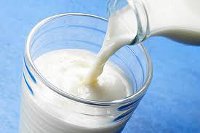Western yoghurts don't fit to hold a candle to Russian kefir
 Every Russian on average drinks 21.5 liters of kefir throughout the year. If one is not a part of this statistic, the situation has to be corrected because this Russian drink is a path to health. The point is not to confuse "live" kefir with its useless fake counterpart. Alas, there has been a great deal of fake product on the shelves of Russian stores lately.
Every Russian on average drinks 21.5 liters of kefir throughout the year. If one is not a part of this statistic, the situation has to be corrected because this Russian drink is a path to health. The point is not to confuse "live" kefir with its useless fake counterpart. Alas, there has been a great deal of fake product on the shelves of Russian stores lately.

These days it became trendy to drink yogurt and other Western dairy products that are meant to improve micro flora and protect the immune system. Yet, some products cannot even hold a candle to Russian kefir. If a plain yogurt contains a maximum of 5.3 species of beneficial microorganisms, kefir contains over 20 of them. In addition, it is not only bacteria but also fungi which have created a unique symbiosis called "kefir starter".
Through their coordinated work the fermented milk drink restores the intestinal flora after taking drugs, clears the body of toxins, improves digestion, strengthens the immune system, normalizes metabolism and thereby promotes weight loss. If you listen to the opinions of nutritionists and begin to drink kefir regularly, in a month you will see tangible results on your face and around the waist. The main thing is to choose the right "live" beverage.
The history of kefir reminds a detective story. According to one theory, the secret starter was stolen from Persia, according to another it was obtained from the Caucasus through blackmailing. In any case, in 1909 industrial production of kefir was commenced in Russia, and now this beverage has an official status of a national Russian drink. Contemporary bacteria and fungi are the ancestors of ancient organisms because the only way to reproduce them is through breeding (the scientists have failed to obtain the new ones). It is difficult to maintain the starter; therefore not every producer is able to manufacture real kefir.
Simplified technology of its manufacturing is as follows: milk is decontaminated through pasteurization, and then in a sterile room at a certain temperature and humidity the starter is added to it, which provokes lactic and alcoholic fermentation. The result is a "live" white dairy drink.
It is not hard to recognize it on the shelves. First, look closely at the name of the product - it should be called "kefir". Then read the content - the classic white beverage contains only two ingredients: milk (whole or normalized) and kefir grains to ferment. Then find the information on the live flora on the label: "The amount of lactic acid microorganisms at the end of shelf life - at least 1 × 10 7-th degree CFU / g. The amount of yeast at the end of shelf life - at least 1 × 10 4 -th degree CFU / g ". And finally, another indication of a "live" kefir is the shelf life of no longer than 14 days. If the beverage can be stored longer, it was subject to heat treatment (preservatives in kefir are prohibited) and has lost its benefits.
Unfortunately, recently many kefir-like products appeared on the shelves of Russian stores. They are made not with live bacteria, but dried bacteria through adding powder to pasteurized milk. The result is a drink that tastes very similar to kefir, but in fact is not entirely the same. By law, it cannot be called kefir and is often referred to as "Kefir product", "kefirchik", "kefir ..." and so on. In addition, the label of the "dead" milk product will not show quantitative indicators of micro-organisms and yeast, and will not contain the starter. Such milk may contain palm fat. These kefir beverages, while safe for health, will not do the body any good.
Vadim Kirillov
Medpulse
Subscribe to Pravda.Ru Telegram channel, Facebook, RSS!


